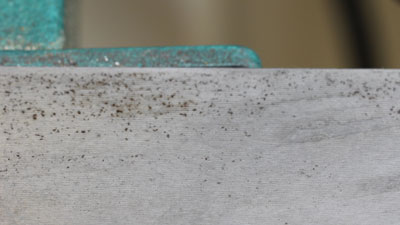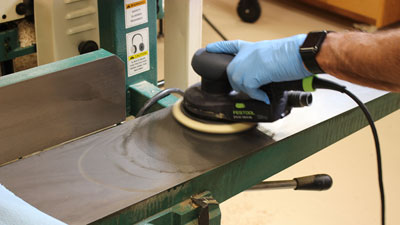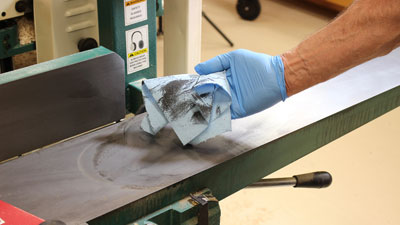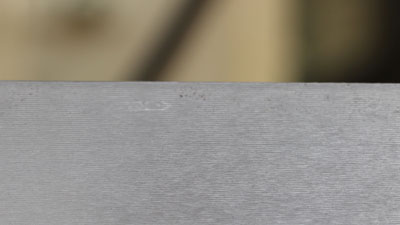
 by Steven D. Johnson
by Steven D. Johnson
Racine, Wisconsin
This month:
•
Climate Change - Rust
•
Climate Change - Rush
•
Climate Change - Flush (What I Learned About Woodworking From My Plumber)
Climate Change - Rust
Click on any picture to see a larger version.
Fifty–odd years ago the so–called "piney woods" section of Texas where I grew up had a drought. Ponds dried up, lakes receded… the pier where I usually dropped a line and fished for perch was over a hundred yards from the edge of the water. A mere two years later we had flooding rains. We measured rainfall, not by the inch, but in a Southern colloquial everyone understood… a "gulley–washer" was what other folks might call torrential rainfall. A "trash–mover" was epic, almost Biblical in proportion. And like the name implied, it was not uncommon to see trash cans being carried down the road on a torrent of water. Yep, those were the days. Were it happening today it would be called climate change and the Texas oil industry would be blamed… or perhaps the Pennsylvania coal industry… or perhaps the collective exhalations or flatulence of our herds of cattle. Well, that was fifty–plus years ago, and the climate is still changing.

|
|
Figure 1 - Rust and pitting on the surface of my jointer
|
Since building my current shop several years ago I have had few, if any, noticeable rust issues on any of my tools. But this year, man oh man! The humidity this summer has been like no other in my memory, more akin to south Louisiana in June. Is this climate change? My normal routine of wiping down every tool with
Boeshield T–9
and my hand tools with
Camellia Oil
had not a fighting chance against the onslaught of 90+% humidity every day for the entire summer. No respite. As I write this, the outdoor humidity is 94%. Every cast iron machine top developed varying degrees of rust spots. Awful. And ugly!
It has been a while since I dealt with rust. My preventive measures always worked… at least before climate change ruined our summer… so I took to the internet to see if there was any new miracle way to remove the offending, unsightly oxidation.
Boeshield Rust Free remover
and elbow grease; mineral spirits, steel wool, and elbow grease;
rust erasers
and lots of elbow grease;
wet–dry sandpaper
and more hard work; a myriad of caustic chemicals with catchy names and more work… nothing struck me as really "new." Everything seemed like a lot of work and I would much rather be working on wood than working on machinery.

|
Figure 2 - The Festool Sander and Vlies pads are
perfect for removing rust
|
So I grabbed one of my
Festool sanders
, a
Vlies polishing pad
(the "A 800" – equivalent to fine or super fine), poured a bit of mineral spirits on the bed of my jointer and got to work. If you do this, don't connect a dust extractor! I think sucking up mineral spirits could be bad, very bad, for the equipment, not to mention potentially a fire hazard.

|
Figure 3 - Wipe off the slurry and repeat until the rag
comes up fairly clean
|
It's hard to describe how much mineral spirits to pour on. I would guess about a tablespoon for each square foot of surface area was what I used… not enough to soak the Vlies pad or damage the sander, but enough to thoroughly wet the surface. Under the action of the Festool sander, the mineral spirits quickly turned black resulting in a slurry of who–knows–what… probably oxidized metal, atmospheric dirt, and bits of the Vlies pad. A big roll of blue shop paper towels should be close at hand. Wipe up the black liquid before the mineral spirits can evaporate, then pour on a little fresh and have at it again. After the third or fourth time, the liquid was not turning black at the same precipitous rate, and the surface was looking really good. The rust spots were all gone, as was all the surface oxidation.

|
Figure 4 - The clean jointer bed looks almost like new
... and it is very slick!
|
Be sure to wear
gloves
and
safety glasses
, open the windows (or better,
wear a respirator
), and put some plastic under and around the machine you are working on to catch any drips or splatters. Do a relatively small section at a time. If the mineral spirits start to dry, stop polishing and wipe up. When satisfied that the rust is gone, put a little mineral spirits on a clean paper towel and give the surface a final wipe–down.
You will notice that in addition to looking much better, the surface is also now very slick. I was tempted to leave it like that, since a slick surface is so much easier when jointing big heavy boards. But don't let that temptation overcome common sense. With a clean surface, new rust will develop quickly if the humidity is high. As soon as I was sure I had removed all of the mineral spirits, I gave the jointer top a good spray of T–9 and wiped off the excess. Beautiful.
(Page 1 of 3)
1
2
3
Next Page
Return to
Wood News
front page
